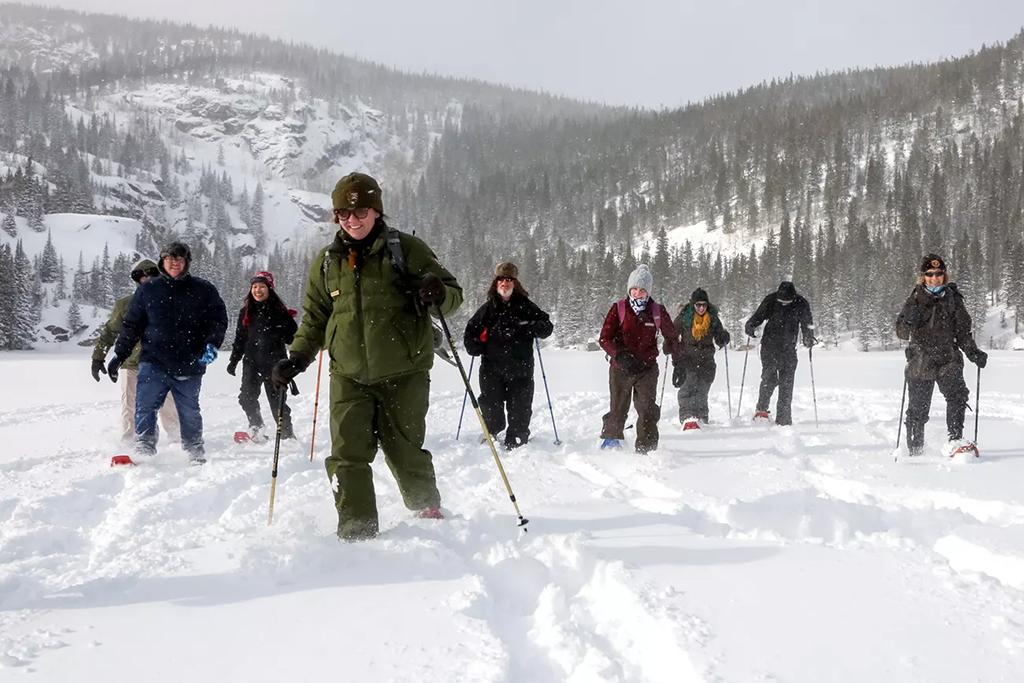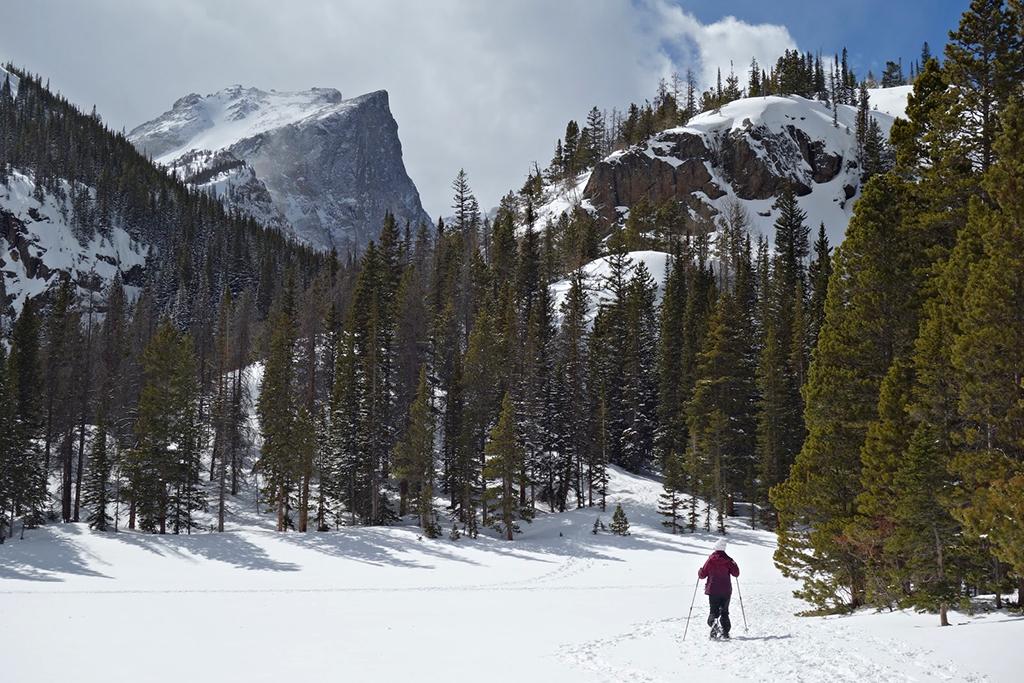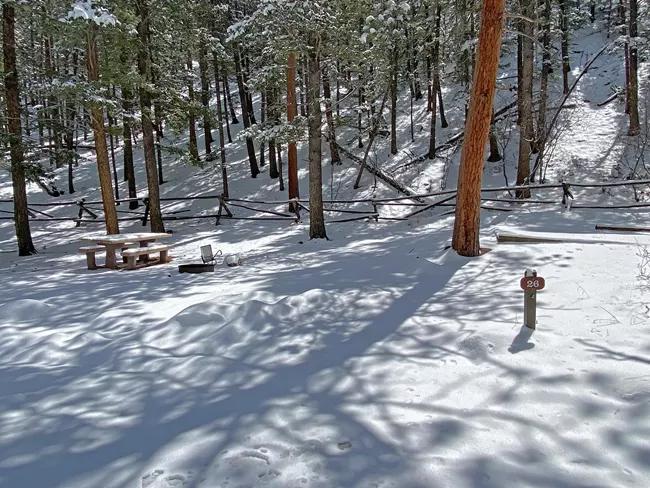Summer is the peak season for outdoor activities in national parks. At Rocky Mountain National Park in Colorado, you can hike, climb, fish, bicycle, horseback ride, observe wildlife, and birdwatch during the months of June through August. Summer is also the busiest season in terms of visitor numbers. July 2024 saw over 750,000 visitors to the park. Winter, however, is much different.

Snowshoe tracks through winter snow at Rocky Mountain National Park / NPS file
When temperatures plummet and tens of feet of snow swath the landscape, you might think things slide to an abrupt halt in the park. Sure, things slow down and some roads/facilities might close, but they don’t completely disappear. This national park offers plenty of activities from October to mid-May for those of you willing to make the effort of getting here. Visitation is much less (105,000 during February 2024) and a deep solitude pervades the park, bringing with it a large dose of snowy fun.
While Trail Ridge and Old Fall River roads are closed to vehicular travel, covered beneath 18 – 25 feet (5.5 – 7.6 meters) of snow or more, you can enjoy the stunning, snow-dusted vistas from these roads on your snowshoes or cross-country skis.
While most of the park’s trails are buried by winter precipitation, there are still a few open for snowshoeing and cross-country skiing: The Pool, Cub Lake, Chasm Falls, Gem Lake. Deer Mountain, and Upper Beaver Meadows. For more detailed information on each of these trails, click here.

Ranger Chelsea Hernandez leading a snowshoe walk on Bear Lake, Rocky Mountain National Park / NPS file
Not sure which trail to take or where to go for your snowshoeing adventure? Join a ranger-led snowshoe hike. There are winter hikes offered on both the west side near Grand Lake, and the east side near Estes Park. No worries if you don’t own a pair of snowshoes as they will be provided specifically for the hikes.
If cross-country skiing is more your sport, be aware nothing is groomed, but there are trails open, with the terrain and snow depth on the west side more conducive to skiing.

Winter snows usher in a new set of outdoor activities for those hardy visitors wishing to visit Rocky Mountain National Park / NPS-Alex Gary Gareis
Speaking of not bringing any snowshoes or skis, you can rent them at Grand Lake on the west side of the park, and Estes Park on the east side.
Would you rather go sledding? Hidden Valley Sledding Hill is the place for this, depending upon conditions. This sledding hill is the only place inside Rocky Mountain National Park where sledding is allowed.
According to Park Staff:
Hidden Valley is located along Trail Ridge Road/U.S. Highway 34, 7 miles [11.3 kilometers] from the Beaver Meadows Entrance and the Fall River Entrance on the east side of Rocky Mountain National Park.
When walking from the Hidden Valley Parking Area to the Sledding Hill, traction devices are advised as the path is icy and there are icy patches in the parking area. Remember to dress warmly. At an elevation of 9,240 feet [2,816.4 meters], Hidden Valley can be very windy and cold.
To go sledding, you will walk your sleds or tubes up the designated sledding hill and sled down. It's a pretty gentle hill. Skiers, snow boarders, and snowshoers may pass, but must use caution around sledders, slow down, and yield the right-of-way to sledders.
There are no tow facilities at Hidden Valley and there are no rentals available inside the park. Plastic sleds, saucers, or tubes can be purchased or rented in communities outside of the park. Sleds with metal runners are NOT allowed to be used on the sledding hill.
- Please obey all signs; you MUST sled within the sledding area boundary.
- Pets are not allowed on the sledding hill.
- The sledding hill is unstaffed. There may be park rangers and volunteers in the area, but for the most part you are on your own and sled at your own risk.
Flush restrooms are open daily. They are located at the bottom of the sledding hill, close to the Hidden Valley Parking Area. The Warming House may be open limited hours on weekends.
When sledding, it is advised to sled feet-first down the hill for your safety. Before sledding, have a plan to slow down and a plan to stop.
Winter Photography
Thinking of bringing your camera with you for your winter foray(s) into the park? You should get some grand images of a landscape altered by winter doses of snow and ice. If you don’t do much winter photography or have never considered capturing a cold-weather image or two, the Traveler articles below provide some tips and techniques to help you capture awesome images.
Featured In The National Parks Traveler
Photography In The National Parks: The Faces Of Winter
Like autumn, winter has many faces within the National Park System. Some park units will be dry as a bone with warm temperatures and no snow, while other park units will produce their share and then some of the white stuff. Most national parks have fewer crowds during this time of year, which is the perfect time for a visit and a little photography, as long as you don’t mind the possible caveats of seasonal or storm-damage-related road closures and trails buried beneath feet of snow.
So, let’s explore the faces of winter, and how to capture great shots. Let’s also discuss the planning involved for a winter park excursion.
To read more of this article, head to this page.
Photography In The National Parks: Winter Wonderlands
Not too long ago, the Traveler published an article about exploring winter in the National Park System. To accompany that article, this month’s photo column is about winter photography within the National Park System. Oh sure, I’ve written about this before, and while I don’t want to sound too redundant, I do want to talk about this subject again, if for no other reason than it’s a nice little refresher course and a good introduction to winter imagery for those of you new to the Traveler.
When I think of winter, the first thing that comes to mind (aside from cold temperatures) is snow. That’s not always the case, depending upon what national park or other public land you visit. Winter in Glacier National Park is very different from a winter sojourn at one of the beaches in Olympic National Park or a trip to someplace warmer, like Hawai'i Volcanoes National Park or Big Bend National Park.
To read more of this article, head to this page.
Photography In The National Parks: Winter Is Coming
Every year, I write something about photography during winter. It might be a repeat for many of you, but there are others out there, new to the Traveler, who haven’t waded through all my photo columns written over the past 11 years. So, this article is for you, and the rest of you stalwart readers may consider it a refresher piece.
Winter is a great time for photography. The atmosphere is clearer. Yes, even on days when the sky is pewter gray, the atmosphere is still clearer. This is because there are fewer water particles in the air during winter than there are in summer. Why? Because cold air can’t hold as much moisture as warm air can, so there is little to no haze, allowing you to capture a clearer shot of the landscape.
To read more of this article, head to this page.

If you feel like pitching a tent beneath a winter-crisp, clear, starry night, Aspenglen Campground is the only campground open during the season. Campsites are $30 per night and first-come, first-served January 1, 2025 – May 18, 2025.





